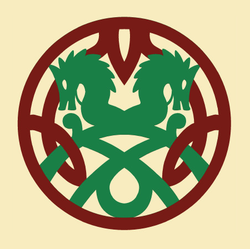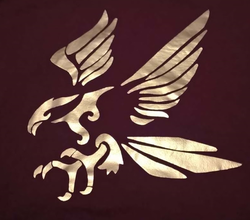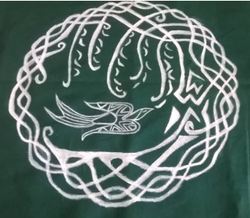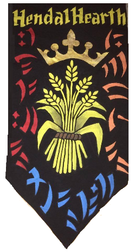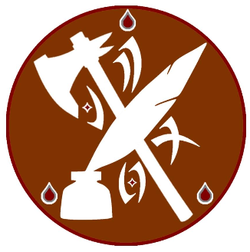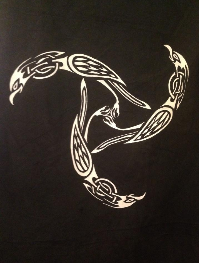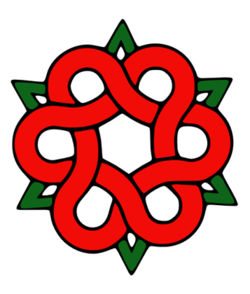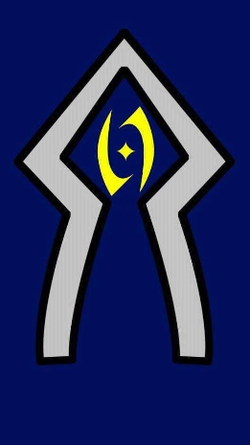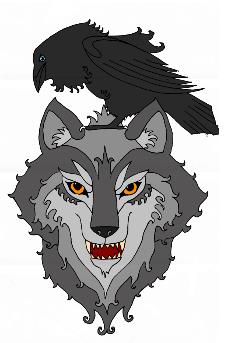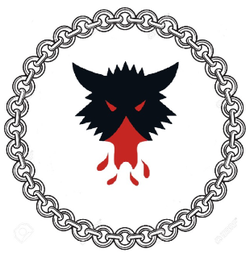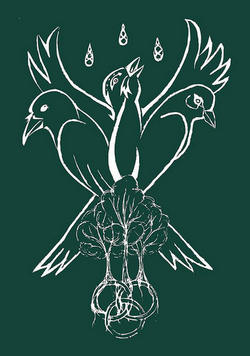Wintermark groups
No edit summary |
mNo edit summary |
||
| Line 38: | Line 38: | ||
'''Hall Banner:''' A Grain bundle beneath a crown surrounded by Runes of Rhyv, Feresh, Zorech, Gralm, Jotra, Irremais, Aesh, Lann, Hirmock, Queros and Pallas.<br> | '''Hall Banner:''' A Grain bundle beneath a crown surrounded by Runes of Rhyv, Feresh, Zorech, Gralm, Jotra, Irremais, Aesh, Lann, Hirmock, Queros and Pallas.<br> | ||
'''Tribes:''' Mixed | '''Tribes:''' Mixed | ||
Hendal Hearth Hall was founded by Winterfolk who left Skarsind following the Skarsind Motion in 379YE. They came from several halls, united by a decision to make a fresh start in Wood Heath. Many of Hendal Hearth still bear grudges over Skarsind, believing a trail of broken promises have followed in | Hendal Hearth Hall was founded by Winterfolk who left Skarsind following the Skarsind Motion in 379YE. They came from several halls, united by a decision to make a fresh start in Wood Heath. Many of Hendal Hearth still bear grudges over Skarsind, believing a trail of broken promises have followed in its wake - oaths not kept and weregild not paid. | ||
Hendal Hearth itself was founded by the late Thane, Bjarne, known as the ''Faithful Defender''. The hall is known both for its extensive [[herb garden|herb gardens]], and for being home to the Winterforge Armouries. | Hendal Hearth itself was founded by the late Thane, Bjarne, known as the ''Faithful Defender''. The hall is known both for its extensive [[herb garden|herb gardens]], and for being home to the Winterforge Armouries. | ||
Revision as of 15:28, 25 September 2018
Overview
There are many halls in Wintermark, but only a comparative handful are involved in the affairs of the Empire (that is, attend the seasonal summits at Anvil. The influence of a hall can wax and wane, and involvement in Imperial affairs is not always a reflection of their influence within the nation itself.
This list was compiled by stormcrow Jorma Steelhail, shortly before the Autumn Equinox 381YE. Original text provided by Michael Durrant
Halls of Hahnmark
Ashenhall
Hall Banner: Two green opposing horse heads amongst red knotwork
Tribes: Mixed
What is now the town of Ashenhall has been through several tumultuous changes in recent history. For a great many years it was a Skarsind settlement known as Steinhall, founded by the legendary Thane Torstein. This changed when the occupation of Skarsind by the Thule began in 373YE. During the initial attacks, many of the town's residents fell defending the town and Steinhall itself was burned to the ground. Under Thane Cadarn the survivors spent the next four years evading the occupying Thule forces, operating mostly out of a nearby mine. When Skarsind was liberated in 377YE, the people of Steinhall returned to the site of their town and founded a new settlement: Ashenhall.
When, in 379YE, the Skarsind Motion was ratified and the territory gifted to the Imperial Orcs, Ashenhall's Thane Cadarn voted in favour of this motion. Following his example, the folk of Ashenhall made the decision to relocate once more. Ashenhall is now situated in Hahnmark near Southridge, south of Kalpaheim. Cadarn's successor, Thane Hellä, oversaw a new construction on the site of a reclaimed Imperial watchtower.
Ashenhall is a growing trading town built on foundations of diversity and hospitality. The people of the town remember what it is like to lose their home and to have to build it up again from nothing, and as a result they are a hardy folk, tempered in flames. With the guidance of Thane Jag, they strive to live forward-looking and virtuous lives, and to bring the same dedication to those values with them to Anvil.
Dunhearth Hall
Hall Banner: Stylised gold eagle on a red field
Tribes: Mostly Steinr, both Suaq and Kallavesi are not uncommon
Located on the southern border of Hahnmark, the Dunnings are a grand family, collectively led by the Thane of Dunhearth Hall. This familial connection is paramount, a kinship that has existed in times of legend long before the Empire and even Wintermark itself. Their progenitors, The Great Dun and the mighty Kára Æxmǣr, came to this world with Vard and Stein. The following tumultuous era saw great sacrifice; both Kára and their daughter Nál fell during a fateful raid against the trolls. Their other daughter Áma founded the Redfeldr, the red cloaks, with the many war orphans the family adopted. This has been the family’s military core since; the Dunnings’ eagle banner leading their descendants through history. The Dun himself carries on as a figure in the family’s oral legend, variously as a gregarious operator, cunning warrior and spiritual guardian until he leaves for the north, passing his authority to whomever the family appoints.
The first Hall was simply a tatty command tent that eventually settled in south Hahnmark during the war with the trolls. The town of Arnburh later grew from that first tent, founded by Gangrǽdan the first Thane of Dunhearth Hall. Once the trolls were defeated the Dunnings protected the southern border of the Kingdom of Wintermark against orc and human alike. Recently, the Dunnings were forced to relocate when Dunhearth Hall was swallowed by a terrible sinkhole leading to the foundation of New Dunhall shortly before the Autumn Equinox 381YE.
The modern family is one of incorporation, the strength of its legacy, and the skills and experience of those who are married and adopted in. This history has lead to many familial lines but all politely refer to each other as ‘cousin’. The hall is notable for its warriors, scops, and artisans. Sitting on a major trade route from the Marches, its prosperity has been ever fed into military support for the Empire. Likewise its brightest have served widely in the various Imperial institutions (although never the Throne).
Fellowship of the Broken Willow
Hall Banner: A white knotwork circle formed from a willow tree, with a distinct slash in the trunk. A small swift flies towards the tree.
Tribes: Mixed
When Skarsind fell, many of its inhabitants were left without homes. The chaos that engulfed them also brought out some of the worst of many halls; families were torn apart and old wounds reopened. In response a wise and proud Steinr woman, Lora Windeltreow, resolved to form her own hall, one without any landed home, partially as a matter of practicality and partially as a small act of protest. The "hall" formed around a traveling caravan and they journeyed throughout Wintermark, trading for what was needed, accepting any and all - outcasts, lost teenagers, and vagrants - so long as they needed a new place to call their own.
Lora’s natural charisma drew many under her banner, and even those who had only intended to stay for a few short seasons found themselves compelled to stay longer. Lora passed away due to illness shortly before the 380YE Winter Solstice, a fact which left the rest of the hall reeling, and struggling to recover. After the Spring Equinox, Lora was committed to the marshes of Kallavesa. Her successor was the group’s head grimnir, as the hall has a number devoted to that art.
Several members own property in Hahnmark, and there are numerous debates among members as to whether or not the hall should settle there permanently. Since Skarsind was given to the Imperial Orcs, these questions are becoming more prominent.
Hendal Hearth
Hall Banner: A Grain bundle beneath a crown surrounded by Runes of Rhyv, Feresh, Zorech, Gralm, Jotra, Irremais, Aesh, Lann, Hirmock, Queros and Pallas.
Tribes: Mixed
Hendal Hearth Hall was founded by Winterfolk who left Skarsind following the Skarsind Motion in 379YE. They came from several halls, united by a decision to make a fresh start in Wood Heath. Many of Hendal Hearth still bear grudges over Skarsind, believing a trail of broken promises have followed in its wake - oaths not kept and weregild not paid.
Hendal Hearth itself was founded by the late Thane, Bjarne, known as the Faithful Defender. The hall is known both for its extensive herb gardens, and for being home to the Winterforge Armouries.
While all three tribes are part of Hendal Hearth, by tradition a Kallavesi can never be thane. Instead, the Kallavesi choose the thanes and serve as advisors. They have chosen their most recent Thane after the death of the founder.
Renweard
Hall Banner: White horse on a green background
Tribes: mixed
Renweard is made up of three halls - Tyrshalt, White Oak, and Ætheling - working together for the good of Wintermark and the Empire. They have been around since the death of Empress Britta and helped reclaim two Crowns for the Empire so far. They form part of the Iron Bastards. Eukenbrand, champion of the people is part of this hall. They strive to help Wintermark fight well on the field, in the Imperial Senate and other places of power.
Rune-sworn Quills
Hall Banner: Crossed white quill and axe on a brown field, surmounted by three drops of blood and the runes Evrom, Jotra, and Ophis
Tribes: Steinr
Little is known about the original Rune-sworn Quills, other than the fact that their words and songs were said to have the power to shape history itself. On the day that Empress Britta died, the Rune-sworn were among the first to spill blood for the Empire and those that survived that day were the first to sing of Britta's Heroism.
In 380YE, the Rune-sworn Quills were re-formed by a scop and a runesmith in the hopes of one day bringing the group back to its former greatness. Though the original were mostly warriors, those who today join the ranks of the Rune-sworn are just as likely to be heroic warriors as they are solemn scops, artful artisans or fearless physics. Being a Rune-sworn Quill is as much an oath of comradeship as it is a desire for wisdom, freedom, and truth.
As their name suggests, the Rune-sworn, like many from Wintermark, regard Runes with much importance. Of all the Runes, the Rune-sworn hold four with utmost importance. These are: Evrom, the Rune of Beginning, Sular, the Rune of Discovery, Jotra, the Rune of Battle, and Ophis, the Rune of Revelation.
Sherard Hunters
Hall Banner: Three stylised silver birds on a black field
Tribes: Predominantly Steinr
Situated near the base of the Fingers in a fertile, wooded valley, Sherard Hall was founded around 270 YE by 'Old' Sherard The Hunter. Starting as little more than a shack but soon blossoming into a thriving homestead, it is used as a staging area for hunts in the surrounding countryside, including into Varushka, where people from all around can try and earn a name for themselves in an attempt to bring in some monstrous quarry from those haunted realms just over the border. As a result of this hub atmosphere, many potential hunters decided to stay and, although predominantly Steinr, members also follow the Suaq and Kallavessi traditions.
The main hall itself is magnificent, long and comfortable, with a fire always burning in the hearth. In the hall, high on the wall above the main seat hangs a great skull of a direwolf and anybody interested can ask for the exciting story of this beast which is tied to the hall's origins. All manner of people visit the Hunters for their famed hospitality and stories, healing ability and prowess in the realm of Spring magic, especially since their performance of an empire wide enchantment during the Spring Equinox 380YE.
They revel in assisting others on small or large scales and it is perhaps this that gives them their motto: “Heart and Hearth”, which has never been forgotten in the hundred years since Old Sherard placed the first foundations.
Sigehold
Hall Banner: Six-petaled red knotwork flower on a field of white
Tribes: Predominantly Steinr
Originally established in Skarsind, after the territory was given to the Imperial Orcs, the Sigehold established a new hall on the Kallavesa border, in Valasmark. Before they left, the stormcrows of Sigehold gathered their Hall’s diverse traditions in a book to be given to the Skywise with whom there is a continued friendship.
The original Sigehold Hall was founded by Striking Ardith (first Warden of the Mark) after her band of resistance fighters had aided in the successful taking of Skarsind. It was formed of those of diverse fallen halls who had come together to fight against the Thule after the Fall.
The banner of Sigehold continues to be used to rally the Heart of the Mark in battle and Sigehold prides itself on its friendship with the smaller halls stemming from its history of being a home for those broken, dispossessed and needing refuge from the Fall. Hospitality in Sigehold is linked closely with food and especially Sigehold Gravlax from their salmon farm. The current Thane is Iron Osric.
Stenstorp
Hall Banner: Face of Sten Rockbeard in gold on a blood red background.
Tribes: Unknown
Stenstorp hall was founded by Sten Rockbeard and his companions after a legendary encounter with the troll Toothcutter, chief of the Rotting Tooth Tribe. Having driven the trolls from the lost Vale of Kivikylma, Sten established a settlement there, which flourished. After a long period of relative peace, barbarian orcs attacked the settlement - and if the tales are to be believed, they were accompanied by a returned Toothcutter himself. They came in such numbers that survivors were forced to flee the Vale of Kivikylma.
Following Sten's eventual passing, successive thanes and generations have sought for The Vale of Kivikylma in vain. Following the recent tragic death of Thane Algar, Stenstorp Hall adopted Sverrir Hordson, an experienced armourer and weapon smith whom they had spent time with in Anvil, as thane.
Currently Stenstorp Hall is based at Sverrir's mining settlement and workshops, Malmurheim, in Hahnmark. It is not clear why the histories transmitted have not allowed Stenstorp Hall to find the Vale of Kivikylma. It is unlikely that the Hall will lose hope of one day returning to their original home.
Stormspire
Hall Banner: A stylised tower with the rune of Vigilance.
Tribes: Mostly Steinr, with some Suaq and Kallavesi
Built atop the tallest peak of the Northspires in Hahnmark, the Stormspire has a commanding view over all of Wintermark and beyond. Their scouts watch the borders for Thule aggression, a duty they take no less seriously for peace treaties. Should the signal be received the great beacon atop Stormspire is lit, followed swiftly by the others in the network; in this way all of Wintermark is warned of trouble.
As much a garrison as a true hall, their commander is known as the Eyes of the North; a title currently held by Thane Raknar Ravenstorm. Though known mostly for their warriors and scouts, they embrace all of Wintermark’s traditions with enthusiasm. Among their number they count many famous scops, runesmiths, icewalkers and more; their head grimnir, Lofyn Bloodbathed, is known across the Mark for her work to restore the Bloodcloaks. Likewise, they watch the roads of the Northern trade network, and their caravan patrols attract numerous traders to the spire. Many of their number were once refugees from Skarsind and elsewhere, Stormspire being both fortified and close to the border of that war-torn land.
It is the warrior tradition for which they are most famed. Their scouts travel the most inhospitable reaches of the 'Mark, and support the spy network on Verthandi. Their warriors strike out in heavy armour, wielding spear and sword to cut down threats they find. Since the death of Empress Britta they have fought in all of the Empire’s major engagements. Their warriors personally recovered the Young Empress’ headless body from the Thule. They reclaimed Winter’s Fury, the banner of Queen Ilsin, from the vallornspawn of Deer’s Folly at a terrible cost. They fought and died at the Battle of Ikka’s Tears, helped recover both the Crown of Three Tears and the Imperial Crown, and were the first to breach the walls of Urith Barath, the great Druj citadel in Reikos.
Halls of Kallavesa
There are currently no prominent Kallavesa halls.
Halls of Sermersuaq
Fjellreven
Hall Banner: Blue three tailed fox on a field of white
Tribes: Primarily Suaq with some Steinr and Kallevesi
Fjellreven Hall has existed in in some form since before the formation of Wintermark as a nation. It was originally a Suaq hall but with the joining of the tribes a greater diversity appeared. The oldest surviving records have the Hall settled in the Silver Peaks near a mountain pass into Skarsind. However with the Silverpeaks being ceded to the Thule the Hall has moved south to East Floes and now sits between the lakes Big Sister and Little Brother just across the water from Wreck.
The Hall has a strong tradition of Icewalkers, artisans and grimnir and has taken great pride in being a centre for the medicinal arts.
Rangers of Nanuk
Hall Banner: Jotra, Verys, Tykonus, Yorn, and Ophis, surmounting a white Nanuk bear on a blue field
Tribes: Mixed
The Hall of the Rangers of Nanuk provides a last offering of warmth and comfort to travellers in the far north of Sermersuaq, a final light before the endless blizzards of Sydanjaa. Originally established by a group of Suaq hunters, the Rangers of Nanuk tasked themselves with guardianship of the north, each Ranger vowing to safeguard the south from the dire beasts that populate the edge of the eternal storm, and to share their knowledge with those who sought to enter it.
Despite their long and proud history, the Rangers first rose to full prominence after the invasion of Skarsind by the Thule empire, where their skill as scouts and couriers delivered vital information and supplies to Skarsind resistance fighters. When, with their assistance, Skarsind was freed of Thule influence, the veterans of that long service returned to the north, and now form the core of the hall's members.
Today, whilst the Suaq tradition is still prominent, the hall has only been strengthened by its inclusion of the Kalavessi and Steinr, where they remain famed for their hospitality and dedication to their duty. Any imperial citizen is welcome around a Ranger fire, where Courage, Loyalty, and ready hospitality are always to be found.
Saker
Hall Banner: There is no specific symbol that represent the Saker, but the iconography used is largely of the Saker falcon.
Tribes: An even mix
The Saker are a semi-nomadic collection of families (or 'hearths') who all band together under the Saker Mother, who as of Spring 380YE is Rheged Redspear. The Saker have lived in Sermersuaq (and occasionally outside it) for longer than even their story traditions recall. Since the death of Britta the Young, the Saker have come to Anvil in force and have been active in a variety of institutions of the Empire.
There are strong changeling and draughir lines within the Saker, though they do not ascribe any large importance to such.
The Saker coven are a potent force with acknowledged mastery of Winter magic, and are known to be pragmatic in their application of magic - especially the grim ritual Quickening Cold Meat.
Sussivari
Hall Banner: A black bird perched on the head of a gray wolf, on a white field
Tribes: Mixed
Close to the border with Skarsind, the Sussivari hall rests on the trod running from the Stonefield Ice Caves across the border past the old site of Pakaanen’s tower. An old hall founded long ago by the Steinr Oystein Korpiss, it has endured since before the creation of the Empire.
It is made up of a full mix of the traditions; members of the hall live and work together at the hall or, in the case of several of the Suaq, nearby in one of the small seasonal hunting settlements. A large number of the hall died fighting alongside Empress Britta whilst trying to defend Skarsind. Loyalty to their fallen kin inspired the new generation of the hall to make the journey to Anvil to take part in Imperial politics and warfare.
While the hall has always counted warriors, icewalkers, mystics, artisans and stormcrows among its number, it has developed a particularly strong arcane tradition in recent years with many members now practicing ritual magic of one form or another. Similarly, since the beginning of the Interregnum and now up to the present day, the hall has provided a high number of stormcrows that are active both within Wintermark and the Imperial Synod.
Halls of Skarsind
OOC Note: Skarsind is not a Wintermark territory; it is the homeland of the Imperial Orcs. As such any character with a personal resource in the territory suffers a penalty to their production. Following the conclusion of the Dogri Thulebane incident in 381YE, Profound Decisions will assume that there is no remaining significant population of Winterfolk in Skarsind. There remain some player character halls, but they are isolated and exceptional and it is our assumption that their numbers will slowly dwindle. It is no longer possible for new Wintermark players to start with their resources in Skarsind.
Blackwatch
Hall Banner: Wolf’s head surrounded by a rune covered chain
Tribes: Steinr and Suaq
Founded during the winter of 377YE by the former huscarl of the Hel-brethren Resistance, the Blackwatch settled itself around a former watch tower bordering the Glen of Shadows in Hercynia that had been used by their now thane and his blood brother during the occupation war against the Thule. Initially a purely Steinr hall, they were soon joined by a number of Suaq over the following year as the hall grew into a small town. With the ceding of Skarsind to the Imperial Orcs the Blackwatch remained and now live alongside members of the Imperial orcs of the Legion Protectorate and the Stormcrows.
The Blackwatch pride themselves on their abilities in handling the Frayed, with the hall dedicating their time to searching them out and putting them on the right path by one of the oldest rites of Wintermark; regaining one's skein through the fire of battle under the watchful eye of the hall’s thane and their guard.
Other
Holt Hyrde
Hall Banner: Three birds above three trees above three rings, in white on a green field
Tribes: Mixed
The Holt Hyrde are nomadic. The term Holt stems back from the earliest days of the Kalavesi. It originally referred to a small copse of trees ideal as a place to lay camp. Over time it variously became known as a word for home, house, hall of lords, and the place close to my heart that I consider my home. It has also often been used symbolically to represent the kingdom of Wintermark.
The Holt Hyrde are protectors of the borders of Wintermark. They seek not glory, and to lead others into glory. They do not seek fame, though the names of others will be sung because of them. They do not seek victory, though the Wintermark will see glory through their actions. They watch over the dark places beyond their homes, walk among the long shadows that threaten to reach out and take their precious lands from them. They learn of the ways of their enemies and seek to understand them, for through knowledge comes victory.
They count among their people the wise, the thoughtful, and the considered. The hunter, the mystic, and the crafter. They task themselves with guiding the stories of the great heroes of Wintermark. They take care in ensuring that heroic tales run longer than they otherwise might. They take pride that the songs or heroes ring with rousing choruses of victory. They take satisfaction in the splintering of the bones of their foes beneath their boots.
The Levy
Hall Banner: The Levy carries a long banner in Green, Gold and Red with flashes of Black. The banner displays the Hall's name, as well the Dire Cow Bessy that decimated the founder's former Hall. A woodsman axe crosses with a sword, along with a Raven's skull. The three symbolise the joining of three halls, as well as paying homage to one of the founding members. The Gold and Green represent Prosperity while the surrounding red represents the blood shed for it.
Tribes: Mixed
"A name is earned, the Levy lives on." The Levy was born from tragedy, the Hall in which the first two members was wiped out by what was claimed to be a Dire Cow. The survivors, now calling themselves the Levy were trying to make a name for themselves when they encountered Hall Asher and a Kallavesi Banner with no name. The three halls joined together, as one seed could grow a tree but many would grow a forest.
The Levy can be considered unorthodox, simple and disorganised from an outsider's view. But they strive to be prosperous, to grow their hall and to earn a name for themselves in battle. Acting Thanes are voted in upon the former's death or stepping down.
Prominent Halls in Play
This list is by no means exhaustive; efforts are made to keep it up to date but due to the sheer amount of work involved the onus lies with the Wintermark players to ensure the information is correct and current.
The majority of halls listed here represent player-character groups. It should go without saying that you should not create a character who is part of one of these halls, or has personal history with one of them, without first clearing it with the appropriate players. You should also check before including other players' houses in your background. The background team are unlikely to approve a background that significantly impacts or involves another player character household without their permission.
Included above are a handful of prominent NPC halls - you may be able to create a character associated with one of these halls but the situation will depend very much on your background and the house in question. It is unlikely that a player character will receive additional benefits for belonging to an NPC hall, and may find their game limited - the thanes of these halls are likely to remain NPCs for example, and are unlikely to give player characters much attention.
